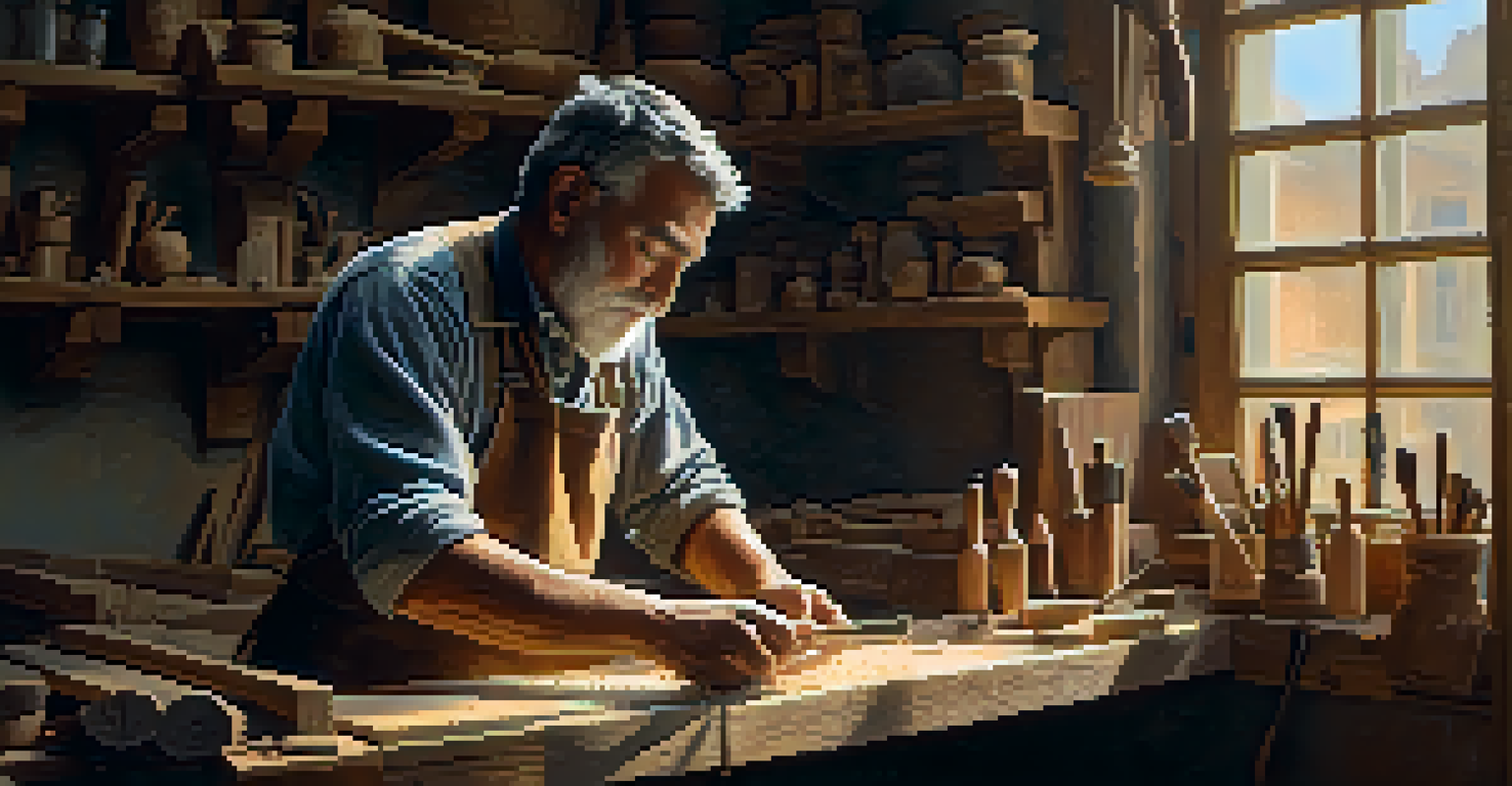Essential Carving Techniques for Antique Furniture Restoration

Understanding the Importance of Carving in Restoration
Carving plays a crucial role in antique furniture restoration, as it helps preserve the original beauty and character of the piece. When restoring antique furniture, maintaining the integrity of the carvings is vital, as they often hold historical significance. This means understanding the original style and techniques used by artisans of the past to replicate them accurately.
The beauty of carving lies in the details. It’s not just about the design; it’s about the history it represents.
Moreover, the carving can tell a story about the era and craftsmanship, making it essential to approach restoration with care. By paying attention to these details, restorers can ensure that the furniture not only looks good but also retains its value. Understanding the importance of carving helps guide the restoration process effectively.
Ultimately, appreciating the art of carving sets the foundation for a successful restoration project. This understanding encourages restorers to invest the time and effort needed to achieve authenticity, ensuring that the piece can be cherished for generations to come.
Basic Tools Needed for Carving Antique Furniture
Before diving into carving, it's essential to gather the right tools. Basic carving tools typically include chisels, gouges, and knives, each designed for specific tasks. While you can find various tools on the market, investing in high-quality ones is crucial for achieving precise results and longevity.

In addition to the carving tools, having a mallet, a fine-toothed saw, and sandpaper will make the process smoother. A mallet helps apply force to the chisels and gouges, while the saw assists in making initial cuts. Sandpaper is vital for smoothing rough edges and finishing touches, ensuring a polished look.
Carving Preserves Furniture's History
Understanding and preserving the original carvings in antique furniture is vital for maintaining its historical significance and value.
Lastly, don't forget safety gear, such as gloves and goggles, to protect yourself during the carving process. As you work, having the right tools at hand not only enhances efficiency but also allows for creativity and accuracy in your restoration efforts.
Identifying Different Carving Styles in Antique Furniture
Antique furniture features various carving styles that reflect cultural and historical influences. From the elaborate designs of Baroque to the simpler lines of Shaker furniture, each style tells a unique story. Familiarizing yourself with these styles can significantly enhance your restoration process.
Restoration is not about making something look new; it’s about preserving the story it tells.
For instance, understanding the difference between relief carving and in-the-round carving helps in determining how to approach a particular piece. Relief carving is a technique where the design is raised above the background, while in-the-round carving involves creating three-dimensional figures. This knowledge can guide your restoration efforts, ensuring that you respect the original craftsmanship.
By identifying the carving style, you can create a restoration plan that honors the piece's history. This not only helps maintain its aesthetic appeal but also adds value, showcasing the artistry involved in its creation.
Techniques for Repairing Damaged Carvings
Damage to carvings can occur over time due to wear and tear, but there are techniques to repair them effectively. One common method is to fill in missing areas with wood filler or epoxy, which can be shaped and carved to match the original design. This approach allows you to restore the piece's integrity without compromising its character.
Another technique involves using a wood patch or scrap wood to replace damaged sections. By carefully shaping the patch to fit seamlessly into the existing carving, you can achieve a flawless restoration. This method requires patience and attention to detail to ensure that the new wood blends well with the old.
Essential Tools for Carving
Gathering high-quality carving tools, including chisels and mallets, is crucial for achieving precise and efficient restoration results.
Lastly, when working on repairs, maintaining the original patina is essential. Avoid over-sanding or altering the finish, as preserving the piece's history is just as important as repairing the damage. These techniques help ensure that the restoration is both functional and visually appealing.
Mastering the Art of Wood Finishing After Carving
After completing your carving work, the next step is wood finishing, which adds protection and enhances the beauty of the piece. Finishing techniques can vary from oils and waxes to varnishes, each offering different levels of sheen and durability. Choosing the right finish is crucial for maintaining the antique's character while providing necessary protection.
For example, using a natural oil finish can bring out the wood's grain while allowing it to breathe, which is often ideal for antique pieces. On the other hand, a varnish might offer a more robust protective layer but can alter the appearance. It's essential to consider the original finish type before applying a new one.
Moreover, applying the finish requires careful technique to avoid drips and uneven surfaces. Patience is key here, as taking the time to apply multiple thin coats often yields the best results. Mastering wood finishing not only enhances the restoration but also ensures that the piece will stand the test of time.
Preserving Original Carvings During Restoration
One of the most significant challenges in antique furniture restoration is preserving original carvings. While repairs and refinishing are often necessary, it's essential to do so without compromising the authenticity of the piece. This means taking a gentle approach and only making changes that are absolutely necessary.
Before starting any restoration work, thoroughly assess the condition of the carvings. Document any existing damage and consider whether it can be repaired or if it needs complete replacement. By prioritizing preservation, you can maintain the piece's historical significance and craftsmanship.
Repair Techniques for Carvings
Effective repair techniques, such as using wood filler and patches, help restore damaged carvings while maintaining the piece's authenticity.
Additionally, using reversible restoration techniques allows for future adjustments without permanently altering the original carvings. This practice not only respects the furniture's integrity but also provides peace of mind for collectors and enthusiasts alike.
Learning from Experienced Restorers and Resources
Restoring antique furniture can be a complex process, and learning from experienced restorers can significantly enhance your skills. Joining workshops or classes can provide hands-on experience and valuable insights into various techniques and approaches. Engaging with a community of restorers allows for sharing knowledge and tips that can improve your craft.
Additionally, online resources, such as tutorials and forums, can be invaluable for learning specific carving techniques. Many experienced restorers share their expertise through videos and blogs, offering step-by-step instructions that can ease the learning curve. Utilizing these resources helps you stay updated on best practices and new tools.

Remember, restoration is both an art and a science, so continuously seeking knowledge will only benefit your skills. By learning from others and utilizing available resources, you can become more confident and proficient in your restoration projects.